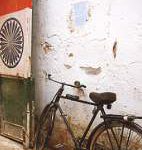The forest of white windmills that make up India’s largest wind farm can be seen from kilometres away. Dotted across 2,000 square kilometres of hills and villages on a basalt plateau in western India sit more than 800 turbines — generating more than 1,000 megawatts (MW) of electricity.
The towering machines, which stand 80 metres tall, cast shadows across fields tilled by man and buffalo — a stark juxtaposition of ancient and modern India. For one man, however, the windmill farm in Dhule is a fitting riposte to the critics who derided his dream to build a global green-energy business from a country plagued by crippling power cuts.
In little more than a decade, Tulsi Tanti has made Suzlon Energy into the world’s fifth-largest producer of wind turbines — selling them at a couple of million dollars apiece. Company turnover in 2007 increased by 29% to US$1.8 billion. About 90% of Suzlon’s order book is from markets outside India — largely the United States, South America and China.
Despite the success, 2008 was a horrible year for the company. While Suzlon should have been reaping the benefits of a world hungry for clean energy, it has been hit by a triple whammy: the credit crunch sent its stock plummeting; cracks appeared in its rotor blades used by US customers, raising doubts over its technology; and the US$1.6 billion acquisition of Germany’s REpower, a turbine maker that produces giant offshore rigs, stalled.
The turbulence has hit the company hard. Suzlon’s stock price crashed 90% since January 2008 to end up trading at only 56 rupees [just over US$1] in December — valuing the Tanti family’s 66% stake at about $US1.2 billion.
Tanti brushes aside these episodes, seeing opportunities where others see crises. In an interview from his Mumbai office, the 51-year-old businessman concedes his paper fortune has been blown away by the economic storm but says the forecast for the company remains good.
Wind power producers, he says, can’t keep pace with demand at a time when concern about global warming is driving governments to promote greener electricity. "Our final product is electricity and that is sold at a fixed price,” he says. “Demand is growing at 5% a year globally and you need [wind power] to prevent climate change and for energy security. It’s the only industry that is going to grow."
Tanti’s rationale is about demand and supply. He says that by 2020, the United States, Europe, China and India will want to have 20% of their power supply from renewables. The issue is about making wind power "cost competitive" with carbon sources, especially coal, which fuels 65% of India’s electricity and costs at least a quarter less.
"Today wind power is just 1% of supply. It can grow to 7% by 2020. That is the maximum because industry has to find resources, material and execute projects. With greater volumes the price [of wind power] will drop … and [governments] will ask what is the cost for pollution from carbon fuels. You will need a carbon tax. "
More worrying, perhaps, were the questions raised about Suzlon’s key technologies. In June 2008, Edison International, one of Suzlon’s biggest customers in the United States, cancelled an order for 150 turbines after cracks appeared in some rotor blades. Many began to fret — and were only reassured when the Indian company shipped out new turbines made of reinforced plastic.
Tanti says these incidents are "nothing new" for an emerging technology and that retrofitting 400 turbines in the United States was the first problem of its kind encountered in more than a dozen years of business. The cost is only $60 million, he says, pointing out that competitors have put aside similar amounts in previous years.
Suzlon’s biggest acquisition has been a rollercoaster ride. The Indian company won a bidding war with French nuclear power group Areva with its $1.6 billion offer for REpower, which makes huge wind turbines.
However, the deal remains in limbo after Suzlon’s initial financing deal fell apart as markets crumbled. In late December 2008, the company announced it would pay 270 million euros [about US$360.8 million] to increase its stake to 91%, the requirement under German law to control the company. Tanti expects to be in charge in early 2009.
REpower is key to Suzlon’s global strategy. Tanti says that by 2020, there will be only five or six global players and that to survive Suzlon needed to be big in the United States, Europe and Asia. Tanti’s logic was that unlike in the United States and Asia, where land is plentiful, in Europe he would need giant offshore wind turbines to produce electricity. REpower’s 5MW generator — double the power output of Suzlon’s biggest turbine — is 100 metres tall and has a rotor diameter of 126 metres. It can only be serviced using a helicopter.
Coupled with this technology and a cost base which is 19% lower than the European company’s, Tanti says he can grow REpower’s business five-fold in a short span.
"It will take three or four years to develop this technology,” he says, “and we need access to European offshore markets. We can reduce the company’s cost and increase their margins and unlock value here."
Few people would bet against Tanti. In 1994 he ran a textile business and bought two wind turbines to power his factories after becoming frustrated with India’s high-cost, erratic electricity supply. Tanti, a trained mechanical engineer, became fascinated by the economics and technology involved.
In the 1990s, western firms had little interest in India and Tanti spotted a gap in the market. He decided to leave textiles and began installing and servicing wind turbines for fast-growing companies in India. By the late 1990s he had built up a large domestic business, partly through convincing state governments to adopt a friendly tax regime for green power.
It is here that Suzlon’s ascent starts, a story of a canny developing-world entrepreneur who saw that India’s cheap but highly trained workforce could undercut rivals abroad. His next move was into manufacturing.
Tanti scoured the world for talent and innovations, buying up mainly European expertise. By 2000 he had set up a German research centre and bought AE-Rotor Techniek, a bankrupt Dutch company, to design rotor blades. With foreign money flowing into India, he floated Suzlon in 2005, raising US$338 million, and began expanding through acquisitions.
A year later, Suzlon bought Belgium’s Hansen Transmissions, a maker of turbine gearboxes, for $566 million. Hansen was a key acquisition — Suzlon got its hands on a component that was in short supply. Tanti sold 28% of Hansen’s stock on the London Stock Exchange, gaining a valuation of more than five times its purchase price.
There’s no doubting Tanti’s global reach. The family joined forces with Arcapita, a Bahrain-based investment bank, to buy China’s Honiton Energy in 2006.
He aims to build Asia’s largest wind farm, exceeding his Indian one in size, in Inner Mongolia, to generate 1,650MW of wind power. The Chinese investment will total more than US$2 billion.
"China has the will to do this,” Tanti says. “The Chinese government has said it wants 100,000MW to come from wind. The country has a large potential of 250,000MW. That is why we have our manufacturing there. We are a Chinese local company, too."
Homepage photo by danielbachhuber
www.guardian.co.uk
Copyright Guardian News and Media Limited 2009



